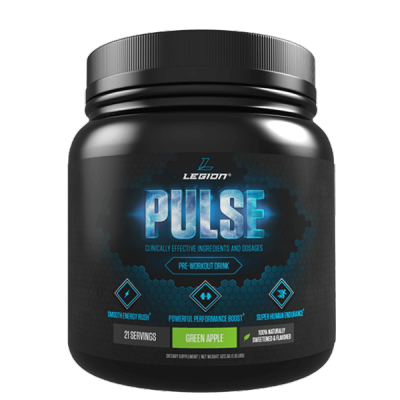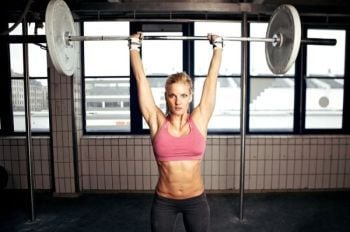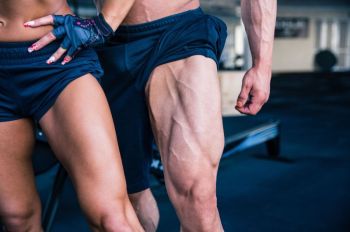There’s a lot of information out there on how to build bigger biceps.
So much, in fact, that if you were to write it all down on individual pieces of paper, you’d singlehandedly destroy a sizeable portion of the world’s forests.
(And what if I told you that was the plot for the next steaming pile of Bond bugcrap?)
Well, in this article, you’re going to get clarity. On a lot of bicepsy things.
Like why they can be as stubborn as a Viagra erection, completely unwilling to grow, what the best exercises for big biceps are, how to improve your biceps’ “peak,” and more.
I’m also going to send you off with a workout plan designed to maximize biceps gains in just 30 days.
This is going to help regardless of your workout experience, too.
Whether you’re new to lifting and unsure of where to even start, a seasoned gym rat looking to break through a plateau, or maybe you’re somewhere in between, you’re at the right place.
Because by the end of this article, you’re going to know exactly what you need to do for more biceps gains in the next 30 days than you’ve seen in the last 30 weeks.
(Hint: it’s more or less what you would think – train your biceps a lot – but isn’t that simplistic.)
I have to warn you, though: it’s not going to be easy.
You can’t get a set of sleeve-tearing, concealed-carry-permit-requiring guns by popping some pills and powders and doing some chin-ups and TRX curls.
So if you’re looking for “weird tricks” or “workout hacks,” then this isn’t for you.
If, however, you’re ready to learn the simple science of building big biceps, and if you’re ready to put in some work, then keep reading.
Table of Contents
What Are the Biceps, Exactly?
The biceps (or, formally, biceps brachii) is a two-headed muscle that looks like this:
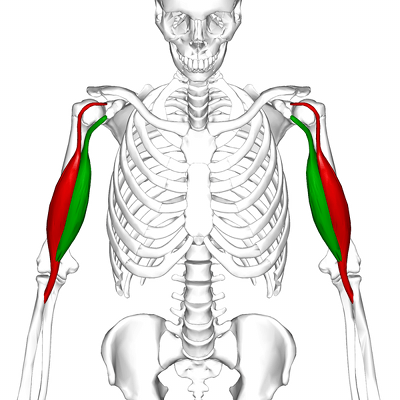
Another muscle you need to know about is the biceps brachialis, which lies beneath the biceps brachii and assists it in flexing at the elbow:
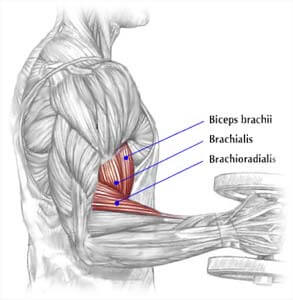
While this muscle isn’t nearly as prominent as the biceps brachii, it plays an important role in the overall appearance of your arms.
When well developed, the brachialis looks like a “knot” in between the biceps brachii and triceps, and it noticeably impacts the overall aesthetics of the arms in two ways:
- It cleanly separates the biceps and triceps when flexed, which better showcases each.
- It pushes the biceps brachii up, giving you a better “peak” when flexing.
For example, here’s a picture of me that I like to think illustrates my point:
There are exercises you can do to emphasize the biceps brachii and there are variations you can do to emphasize the biceps brachialis.
I’m going to have you do both.
Biceps Building 101
How to Get Bigger and Stronger Biceps
There are a lot of theories out there about how to best train your biceps.
- Some people say you have to focus on high-rep training and really feel the burn.
- Others say you should be training them several times per week.
- Others still say you don’t have to do biceps exercises at all and should focus on compound pulling movements instead.
Well, I’ve tried all the above and more, and I’ve worked with thousands of people, and here’s what I’ve learned:
1. Most of us can’t get the biceps we really want through pulling alone.
Hitting your back hard and heavy will help the biceps along, but for most of us, it just isn’t enough to get the size and strength we want.
We have to train the biceps directly to get there.
2. Heavy barbell and dumbbell curls are best for adding strength and size.
Many people think that the biceps won’t grow much with heavy (80%+ of 1RM) weightlifting — that you have to focus on getting a pump.
They’re wrong.
While the biceps are small, they’re also comprised mostly of type II muscle fibers, which they respond very well to heavy loads.
(If you’re not familiar with the different types of muscle fibers, check out this article.)
3. One heavy biceps workout per week is generally enough.
A big part of getting big biceps is getting your weekly volume right, which is the total amount of reps that you do every week.
Here’s a general rule of thumb when talking weightlifting volume:
The heavier you train, the fewer reps you can do each week before symptoms of overtraining set in.
This is especially true of compound exercises like the deadlift and squat. The heavier you pull and squat, the more time your body needs to recover from the workouts.
I’ve tried many different workout splits and frequency schemes, and what I’ve found works best is in line two extensive reviews on the subject.
When your training emphasizes heavy weights (80 to 85%+ of 1RM), optimal volume seems to be about 60 to 70 reps performed every 5 to 7 days.
This doesn’t just apply to the biceps, of course — it applies to every major muscle group that you train.
Now, before you rush off to do 60 to 70 reps of heaving curling this week, don’t forget that the biceps are heavily involved in your pulling.
If you’re doing, let’s say, about 60 reps of pulling per week for your back, then an additional 60 reps of biceps training is probably too much.
Something closer to 30 to 40 reps of direct biceps work per week (in addition to the pulling) is a better baseline to work from.
Now, I’m going to have you do more than this for the next 30 days, but that’s only because we’re looking to temporarily push your bis to their limits (and then back off).
The Best Way to Get Bigger Biceps
The Diet
You probably know that exercise alone isn’t enough to gain muscle and lose fat.
Ultimately, your success or failure is going to be decided by your diet.
Think of it like this:
If your body were a car, exercise is the gas pedal and diet is the fuel in the tank.
You have to step on the gas (exercise) to get moving (improve your body composition)…
…but how far will you get without enough of the right fuel?
My point is this:
If you know how to manage your fuel (diet) properly, building muscle and burning fat will be easy and straightforward.
If you don’t, it will be ridiculously difficult …if not impossible.
That’s why it’s not enough to just give you a 30-day workout routine. We need to set your diet up properly as well.
I break it all down in this in-depth guide to meal planning, which I highly recommend you read and implement in conjunction with the workouts.
If you don’t, you simply won’t get as much out of them as you should.
The Best Way to Get Bigger Biceps
The Exercises
Ignore the muscle mags.
You don’t need to do fifty types of curls to build great biceps.
In fact, out of the scores and scores of biceps exercises you could do, only a small handful are really necessary.
And they are as follows…
1. Barbell Curl
The barbell curl is the bench press of the biceps — it’s one of the best all-around biceps exercises you can do.
2. E-Z Bar Biceps Curl
The E-Z Bar variant of the barbell curl gives your wrists and elbows a break from the strain of the conventional curl.
3. Alternating Dumbbell Curl
Like the barbell curl, the dumbbell curl has been used to train the biceps since the advent of bodybuilding.
It works.
4. Hammer Dumbbell Curl
You’ve probably heard that this exercise can improve your biceps peak.
Well, it can because it’s particularly effective for training the biceps brachialis (which, we recall, gives the biceps brachii a little visual boost).
5. Chin-Up
The chin-up is a fundamental bodyweight exercise that hits the biceps more than the pull-up.
As you get stronger, you can increase the difficulty with a dip belt or weighted vest.
Remember: Progression Is the Key to Muscle Growth
That’s it for the exercises you’ll be doing.
The key, however, isn’t just doing the exercises, it’s progressing on them. That is, increasing the amount of weight you can move over time.
Remember: If you don’t get stronger, you won’t get bigger.
But if you do gain strength on these exercises and eat enough food to grow, your biceps will respond.
The Best Way to Get Bigger Biceps
The Workouts
We’ve covered a lot so far:
- The ideal approach to biceps building
- The physiology of muscle growth
- How to eat right
- The best biceps exercises for gaining size and strength
And now it’s time to hit the gym and make some biceps gains!
Step one is outlining our goal for the next 30 days, and that’s focusing the majority of our time and energy on maximizing biceps growth.
As you’ll see, we’re not going to neglect the rest of the body, but we’re going to dial everything else back (reducing both intensity and volume) so we can really hammer our arms for a month.
That’s why this is a 30-day program, by the way.
It’s not a balanced whole-body routine that you should do for an extended period of time. It’s a tool you can use periodically to “shock” your bis into growing and, once that has been accomplished, that should be returned to the toolbox.
So, here’s the workout plan:
Day 1
Pull
Barbell Deadlift
Warm up and 3 sets of 4 to 6 reps
Barbell Row
3 sets of 4 to 6 reps
Chin-Up
3 sets to failure (bodyweight)
(Not sure how to do these back exercises? Check out this article.)
Day 2
Push
Incline Barbell Bench Press
Warm up and 3 sets of 4 to 6 reps
Incline Dumbbell Bench Press
3 sets of 4 to 6 reps
Close-Grip Bench Press
3 sets of 4 to 6 reps
Seated or Standing Military Press
3 sets of 8 to 10 reps
(Not sure how to do these exercises? Check out this and this.)
Day 3
Biceps A
Barbell Curl
Warm-up and 3 sets of 4 to 6 reps
Alternating Dumbbell Curl
3 sets of 4 to 6 reps
Hammer Curl
3 sets of 4 to 6 reps
Day 4
Legs
Barbell Back Squat
Warm-up sets and then 3 sets of 4 to 6 reps
Barbell Front Squat
3 sets of 4 to 6 reps
Romanian Deadlift
3 sets of 4 to 6 reps
(Not sure how to do these exercises? Check out this article.)
Day 5
Biceps B
Barbell Curl
Warm-up and 3 sets of 8 to 10 reps
Hammer Curl
3 sets of 8 to 10 reps
Chin-Up
3 sets to failure (bodyweight)
Day 6
Rest
Day 7
Rest
Take measurements, do four weeks of those workouts (sticking to your meal plan!), and measure again. I promise you that your biceps will be bigger.
(By the way, if you want to add in work for your abs and calves, you can.)
I also recommend that you take a week to deload before resuming your normal training as your body will probably need a break.
A few points to keep in mind while you’re doing these workouts…
Rest 3 minutes in between your 4-to-6-rep sets and 2 minutes in between your 8-to-10-rep sets.
This will give your muscles enough time to fully recoup their strength so you can give maximum effort each set.
You don’t have to push to absolute muscle failure every set, but you need to come close.
The subject of whether to train to failure (the point at which you can no longer keep the weight moving and have to end the set) or not is a contentious one.
Experts disagree left and right, legit-sounding scientific arguments can be made for a variety of positions, and many people report success with many different approaches.
Well, I break it all down in this article, but here’s the long story short:
We should be training to failure, but not so much that we risk injury or overtrain.
What that comes out to will vary from person to person.
Personally, I never train to failure for more than 2 to 3 sets per workout, and never on the squat, deadlift, bench press, or military press, as it can be dangerous.
Furthermore, I don’t recommend you train to failure when you’re using very heavy loads (1 to 4 rep range).
Instead, the majority of your sets should be taken to the rep preceding failure (the last rep you can perform without assistance).
If you’re new to weightlifting, finding this point will be tricky, but as you get used to your body and your lifts, you’ll get a feel for it.
Once you hit the top of your rep range for one set, you move up in weight.
This is the easiest way to ensure you’re progressively overloading your muscles.
For instance, if you get 6 reps on your first set of your barbell curls, you add 5 pounds to each side of the bar for your next set and work with that weight until you can curl it for 6 reps, and so forth.
What About Supplements?
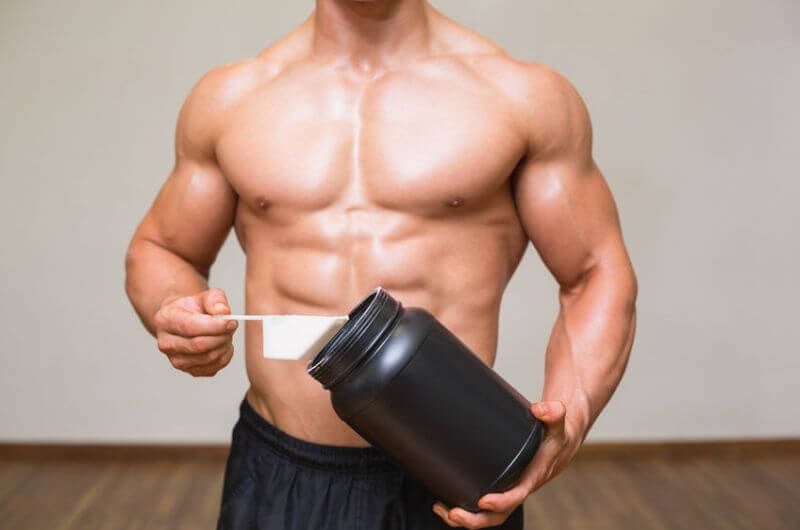
I saved this for last because, quite frankly, it’s far less important than proper diet and training.
You see, supplements don’t build great physiques–dedication to proper training and nutrition does.
Unfortunately, the workout supplement industry is plagued by pseudoscience, ridiculous hype, misleading advertising and endorsements, products full of junk ingredients, underdosing key ingredients, and many other shenanigans.
Most supplement companies produce cheap, junk products and try to dazzle you with ridiculous marketing claims, high-profile (and very expensive) endorsements, pseudo-scientific babble, fancy-sounding proprietary blends, and flashy packaging.
So, while workout supplements don’t play a vital role in building muscle and losing fat, and many are a complete waste of money…the right ones can help.
The truth of the matter is there are safe, natural substances that have been scientifically proven to deliver benefits such as increased strength, muscle endurance and growth, fat loss, and more.
As a part of my work, it’s been my job to know what these substances are, and find products with them that I can use myself and recommend to others.
Finding high-quality, effective, and fairly priced products has always been a struggle, though.
That’s why I took matters into my own hands and decided to create my own supplements. And not just another line of “me too” supplements–the exact formulations I myself have always wanted and wished others would create.
I won’t go into a whole spiel here, but if you want to learn more about my supplement line, check this out. (And if you’d like to know exactly what supplements to take to reach your fitness goals, take the Legion Supplement Finder Quiz.)
For the purpose of this article, let’s just quickly review the supplements that are going to help you get the most out of your biceps (and other) workouts.
Creatine
Creatine is a substance found naturally in the body and in foods like red meat. It’s perhaps the most researched molecule in the world of sport supplements–the subject of hundreds of studies–and the consensus is very clear:
Supplementation with creatine helps…
You may have heard that creatine is bad for your kidneys, but these claims have been categorically and repeatedly disproven. In healthy subjects, creatine has been shown to have no harmful side effects, in both short- or long-term usage. People with kidney disease are not advised to supplement with creatine, however.
If you have healthy kidneys, I highly recommend that you supplement with creatine. It’s safe, cheap, and effective.
In terms of specific products, I use my own, of course, which is called RECHARGE.
RECHARGE is 100% naturally sweetened and flavored and each serving contains:
- 5 grams of creatine monohydrate
- 2100 milligrams of L-carnitine L-tartrate
- 10.8 milligrams of corosolic acid
This gives you the proven strength, size, and recovery benefits of creatine monohydrate plus the muscle repair and insulin sensitivity benefits of L-carnitine L-tartrate and corosolic acid.
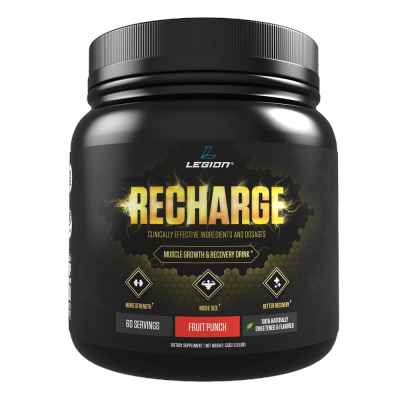
Protein Powder
You don’t need protein supplements to gain muscle, but, considering how much protein you need to eat every day to maximize muscle growth, getting all your protein from whole food can be impractical.
That’s the main reason I created (and use) a whey protein supplement. (There’s also evidence that whey protein is particularly good for your post-workout nutrition.)
WHEY+ is 100% naturally sweetened and flavored whey isolate that is made from milk sourced from small dairy farms in Ireland, which are known for their exceptionally high-quality dairy.
I can confidently say that this is the creamiest, tastiest, healthiest all-natural whey protein powder you can find.
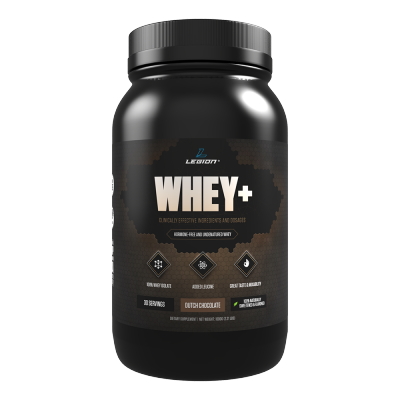
Pre-Workout Drink
There’s no question that a pre-workout supplement can get you fired up to get to work in the gym. There are downsides and potential risks, however.
Many pre-workout drinks are stuffed full of ineffective ingredients and/or minuscule dosages of otherwise good ingredients, making them little more than a few cheap stimulants with some “pixie dust” sprinkled in to make for a pretty label and convincing ad copy.
Many others don’t even have stimulants going for them and are just complete duds.
Others still are downright dangerous, like USPLabs’ popular pre-workout “Jack3d,”which contained a powerful (and now banned) stimulant known as DMAA.
Even worse was the popular pre-workout supplement “Craze,” which contained a chemical similar to methamphetamine.
The reality is it’s very hard to find a pre-workout supplement that’s light on stimulants but heavy on natural, safe, performance-enhancing ingredients like beta-alanine, betaine, and citrulline.
And that’s why I made my own pre-workout supplement. It’s called PULSE and it contains 6 of the most effective performance-enhancing ingredients available:
- Caffeine. Caffeine is good for more than the energy boost. It also increases muscle endurance and strength.
- Beta-Alanine. Beta-alanine is a naturally occurring amino acid that reduces exercise-induced fatigue, improves anaerobic exercise capacity, and can accelerate muscle growth.
- Citrulline Malate. Citrulline is an amino acid that improves muscle endurance, relieves muscle soreness, and improves aerobic performance.
- Betaine. Betaine is a compound found in plants like beets that improves muscle endurance, increases strength, and increases human growth hormone and insulin-like growth factor 1 production in response to acute exercise.
- Ornithine. Ornithine is an amino acid found in high amounts in dairy and meat that reduces fatigue in prolonged exercise and promotes lipid oxidation (the burning of fat for energy as opposed to carbohydrate or glycogen).
- Theanine. Theanine is an amino acid found primarily in tea that reduces the effects of mental and physical stress, increases the production of nitric oxide, which improves blood flow, and improves alertness, focus, attention, memory, mental task performance, and mood.
And what you won’t find in PULSE is equally special:
- No artificial sweeteners or flavors..
- No artificial food dyes.
- No unnecessary fillers, carbohydrate powders, or junk ingredients.
The bottom line is if you want to know what a pre-workout is supposed to feel like…if you want to experience the type of energy rush and performance boost that only clinically effective dosages of scientifically validated ingredients can deliver…then you want to try PULSE.
Again, if you feel confused about what supplements you should take to reach your goals, take the Legion Supplement Finder Quiz to learn exactly what supplements are right for you. It’s the best way to ensure you get the most out of your supplement regimen.


